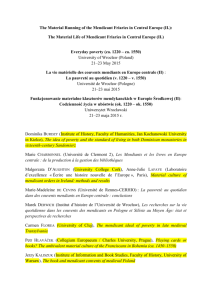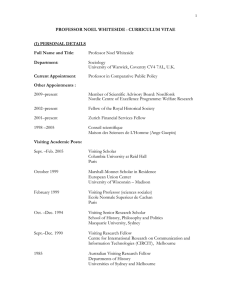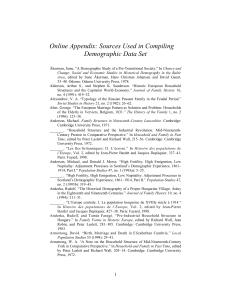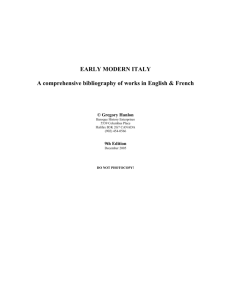Médailles sur les principaux événements du règne de Louis le Grand
advertisement
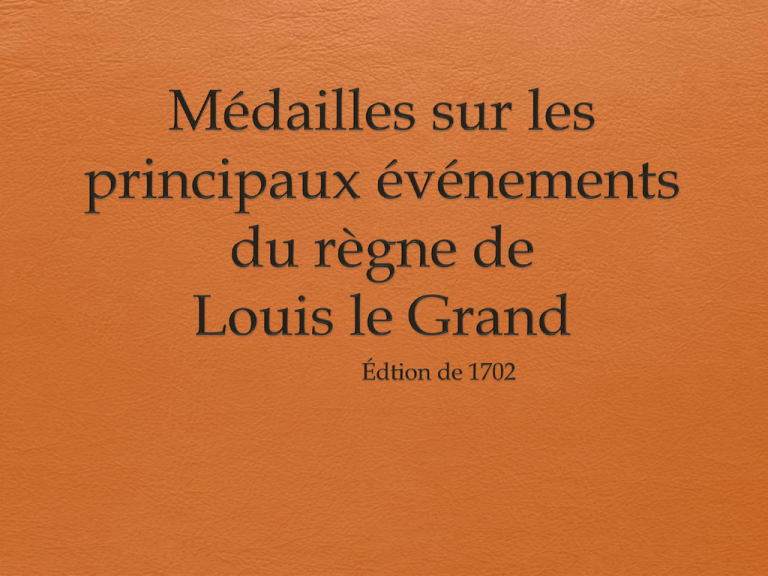
Medals and books: what binds them? The medallion on the cover of the most decorative bindings Humanists as collectors Portraits on medals (Pisanello, 1395-c. 1455) In antiquity, portraits on coins, sarcophagi, steles The first numismatic books: G. Budé, De asse et partibus eius (1514) A. Fulvio, Illustrium imagines (1517) The first numismatic books Budé’s De asse emphasizes weights and measures, as well as the philological dimension of the study of coins; there are no illustrations Fulvio’s Illustrium imagines provides portraits, about onethird of which are taken from ancient sources, but the majority of which are imaginary. The illustrious persons are chosen for their exemplary, heroic conduct. The book has a didactic function, but its aesthetic dimension is at least of equal interest. At mid-century, books of medals were commissioned by families like the Medici for self promotion. The book of medals, at the intersection of history, art and literature In 1602, Rascas de Bigarris proposes a medallic history to Henri IV. In 1663, J. Chapelain agrees with minister Colbert that medals represent the best way to glorify the young Louis XIV: metal endures, and its truth claims are solid. In 1689, the Jesuit Claude-François Menestrier publishes an Histoire de Louis le Grand par les médailles – a book considered defective by Louis’s ministers, lacking in quality and coherence. Only the crown would (legally) strike medals of Louis XIV from that time. What was the function of history for the early modern era? For humanists, an instrument for reflecting on public affairs and political power. The monarch is in particular need of the wisdom of history. (See for example Jean Bodin, Methodus ad facilem historiarum cognitionem, 1566.) For several 17th-century writers: an instrument for uncovering the mechanisms of political power. (See for example Amelot de la Houssaye, Histoire du gouvernement de Venise, 1676.) For the majority, it was a school of virtue. (See for example René Rapin, Instructions pour l’histoire, 1677.) The majority view Events recounted by history should be important: Events recounted by history should be worthy of public contemplation: About major figures (e.g. monarchs and generals; few women) About major events (not everyday life) Morally uplifting Esthetically pleasing: the style must be noble, pure, beautiful In 1677, Jean Racine and Nicolas Boileau-Despréaux are named Royal Historiographers. The tradition of men of letters as the Monarch’s historians dates from the time of Budé. Style and taste By 1677, hyperbole in praise of Louis XIV dominated discourse about the King. But hyperbole was increasingly considered in bad taste in “classical” style. The Petite Académie, founded in 1663, had the control of discourse about the King as its principal goal, with only praise (encomium) permitted. Racine and Boileau wrote little, seemingly paralyzed by the tension between singing the King’s glory and maintaining standards of taste. In 1991, the Petite Académie became the Académie Royale des Inscriptions. The history in medals became their sole project in 1692; Racine and Boileau were members. Médailles sur les principaux événements du règne de Louis le Grand First edition, 1702: 286 medals reproduced in print; last edition, 1723: 316. The only complete history of the reign published during the reign of Louis XIV (1661-1715). A new method for a new project: no previous examples were worthy of the Academy’s attention as men of letters. A traditional goal: to please and to instruct, according to Horace’s dictum. On the medal, equal attention to design, to image and to text. Ainsi les Lecteurs auront plus d’un plaisir à la fois ; ils verront l’image du grand évenement ; ils liront le détail abregé ; ils jugeront du tour ingénieux que l’invention de la Médaille présente à l’esprit ; ils trouveront de la diversité dans les desseins & dans les Légendes, & pourront tout ensemble s’amuser & s’instruire. Préface, de l’Abbé Paul Tallement (suppressed for second prinitng, 1702) Reading and interpretation The image is a puzzle, a riddle. To understand them takes time and effort, which will be rewarded when the reader unlocks the meaning. The reader must continually switch between image and text, taking in the page layout, the border, the title, the design of the obverse and the reverse of each medal, the text of the legend on the medal, and the textual description of the medal. Reading is inevitably non-linear. First impressions don’t count: Peut-estre, qu’à la veuë de plusieurs de nos Médailles, fort simples, & en apparence si aisées à trouver, on se figurera qu’elles ne demandent pas de grands efforts d’imagination. Cependant si les Lecteurs veulent bien se souvenir, qu’en tout genre d’ecrire rien ne vaut la noble simplicité, et ne couste tant que le tour naturel, ils désavoueront leur jugement précipité, & pourront enfin remarquer, ce que le premier coup d’œil n’apperçoit pas toujours. Préface…
